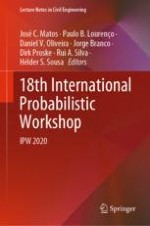2021 | OriginalPaper | Chapter
Probabilistic FEM-Analysis for the Retaining Wall of a Deep Excavation at SLS
Authors : Alexandra Ene, Timo Schweckendiek, Horatiu Popa
Published in: 18th International Probabilistic Workshop
Publisher: Springer International Publishing
Activate our intelligent search to find suitable subject content or patents.
Select sections of text to find matching patents with Artificial Intelligence. powered by
Select sections of text to find additional relevant content using AI-assisted search. powered by
